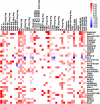Prognostic microRNA/mRNA signature from the integrated analysis of patients with invasive breast cancer
- PMID: 23589849
- PMCID: PMC3645522
- DOI: 10.1073/pnas.1304977110
Prognostic microRNA/mRNA signature from the integrated analysis of patients with invasive breast cancer
Abstract
The optimal management of breast cancer (BC) presents challenges due to the heterogeneous molecular classification of the disease. We performed survival analysis on a cohort of 466 patients with primary invasive ductal carcinoma (IDC), the most frequent type of BC, by integrating mRNA, microRNA (miRNA), and DNA methylation next-generation sequencing data from The Cancer Genome Atlas (TCGA). Expression data from eight other BC cohorts were used for validation. The prognostic value of the resulting miRNA/mRNA signature was compared with that of other prognostic BC signatures. Thirty mRNAs and seven miRNAs were associated with overall survival across different clinical and molecular subclasses of a 466-patient IDC cohort from TCGA. The prognostic RNAs included PIK3CA, one of the two most frequently mutated genes in IDC, and miRNAs such as hsa-miR-328, hsa-miR-484, and hsa-miR-874. The area under the curve of the receiver-operator characteristic for the IDC risk predictor in the TCGA cohort was 0.74 at 60 mo of overall survival (P < 0.001). Most relevant for clinical application, the integrated signature had the highest prognostic value in early stage I and II tumors (receiver-operator characteristic area under the curve = 0.77, P value < 0.001). The genes in the RNA risk predictor had an independent prognostic value compared with the clinical covariates, as shown by multivariate analysis. The integrated RNA signature was successfully validated on eight BC cohorts, comprising a total of 2,399 patients, and it had superior performance for risk stratification with respect to other RNA predictors, including the mRNAs used in MammaPrint and Oncotype DX assays.
Conflict of interest statement
The authors declare no conflict of interest.
Figures




Similar articles
-
Genomic instability-derived plasma extracellular vesicle-microRNA signature as a minimally invasive predictor of risk and unfavorable prognosis in breast cancer.J Nanobiotechnology. 2021 Jan 12;19(1):22. doi: 10.1186/s12951-020-00767-3. J Nanobiotechnology. 2021. PMID: 33436002 Free PMC article.
-
DNA methylation contributes to deregulation of 12 cancer-associated microRNAs and breast cancer progression.Gene. 2017 Mar 10;604:1-8. doi: 10.1016/j.gene.2016.12.018. Epub 2016 Dec 18. Gene. 2017. PMID: 27998789
-
Identification of miRNA-Based Signature as a Novel Potential Prognostic Biomarker in Patients with Breast Cancer.Dis Markers. 2019 Dec 30;2019:3815952. doi: 10.1155/2019/3815952. eCollection 2019. Dis Markers. 2019. PMID: 31976020 Free PMC article.
-
New Advances in Molecular Breast Cancer Pathology.Semin Cancer Biol. 2021 Jul;72:102-113. doi: 10.1016/j.semcancer.2020.03.014. Epub 2020 Apr 5. Semin Cancer Biol. 2021. PMID: 32259641 Review.
-
Diagnostic tests based on gene expression profile in breast cancer: from background to clinical use.Tumour Biol. 2014 Sep;35(9):8461-70. doi: 10.1007/s13277-014-2366-2. Epub 2014 Jul 23. Tumour Biol. 2014. PMID: 25048969 Review.
Cited by
-
Profiles of immune infiltration in colorectal cancer and their clinical significant: A gene expression-based study.Cancer Med. 2018 Sep;7(9):4496-4508. doi: 10.1002/cam4.1745. Epub 2018 Aug 16. Cancer Med. 2018. PMID: 30117315 Free PMC article.
-
TACCO, a Database Connecting Transcriptome Alterations, Pathway Alterations and Clinical Outcomes in Cancers.Sci Rep. 2019 Mar 7;9(1):3877. doi: 10.1038/s41598-019-40629-z. Sci Rep. 2019. PMID: 30846808 Free PMC article.
-
Identification of potential prognostic microRNA biomarkers for predicting survival in patients with hepatocellular carcinoma.Cancer Manag Res. 2018 Apr 13;10:787-803. doi: 10.2147/CMAR.S161334. eCollection 2018. Cancer Manag Res. 2018. PMID: 29713196 Free PMC article.
-
The role of microRNAs in human breast cancer progression.Tumour Biol. 2014 Jul;35(7):6235-44. doi: 10.1007/s13277-014-2202-8. Epub 2014 Jun 18. Tumour Biol. 2014. PMID: 24938874 Review.
-
Whole blood microRNAs as a prognostic classifier for acute respiratory distress syndrome 28-day mortality.Intensive Care Med. 2016 Nov;42(11):1824-1825. doi: 10.1007/s00134-016-4462-9. Epub 2016 Aug 9. Intensive Care Med. 2016. PMID: 27506755 Free PMC article. No abstract available.
References
-
- Shipitsin M, et al. Molecular definition of breast tumor heterogeneity. Cancer Cell. 2007;11(3):259–273. - PubMed
Publication types
MeSH terms
Substances
Grants and funding
LinkOut - more resources
Full Text Sources
Other Literature Sources
Medical
Miscellaneous

